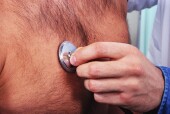 |
 |
 |

Guidelines Unveiled for Treating Clogged Heart Arteries
A key deciding factor should be that benefits outweigh risks, experts say|
|
HealthDay
By Kevin McKeever
Thursday, January 8, 2009
 THURSDAY, Jan. 8 (HealthDay News) -- Treating patients with symptoms of clogged arteries could become more effective now that leading U.S. cardiology groups have published guidelines for deciding how best to proceed.
THURSDAY, Jan. 8 (HealthDay News) -- Treating patients with symptoms of clogged arteries could become more effective now that leading U.S. cardiology groups have published guidelines for deciding how best to proceed.
"Appropriate Use Criteria for Coronary Revascularization," which has been published online and in several leading heart journals, is said to be the first set of guidelines focused on treatment rather than diagnostic testing. The guidelines clarify under what conditions people with chest pain should be treated with just medication and therapy -- or with that combination plus revascularization.
Revascularization is the medical procedure in which proper blood flow to the heart is restored through bypass surgery or use of a balloon-tipped catheter that breaks up plaque in the arteries.
The guidelines categorize people by four main criteria: severity and type of symptoms; plaque levels in the arteries; amount of ischemia (how badly the heart muscle is starved for blood and oxygen, based on stress testing); and whether they already use heart medication.
"One of the strengths of this document is that it provides a framework for thinking about clinical scenarios and having a discussion about coronary revascularization," Dr. Manesh R. Patel, chairman of the appropriate use criteria writing group and an assistant professor of medicine at Duke University and the Duke Clinical Research Institute, said in a news release issued by the American College of Cardiology. "These recommendations describe when coronary revascularization would be expected to improve a patient's health status."
The guidelines were developed by a 17-member panel of experts from the American College of Cardiology, the Society for Cardiovascular Angiography and Interventions, the Society of Thoracic Surgeons, the American Association for Thoracic Surgery, the American Heart Association and the American Society of Nuclear Cardiology. The panel examined 180 clinical scenarios to determine when revascularization or other measures were appropriate.
The guidelines call for revascularization only if the potential for health and quality-of-life improvements outweigh the possible risks. People with plaque buildup in less than three arteries and little heart muscle at risk, who experience symptoms only during strenuous exercise and are not on medication are not considered candidates for revascularization. The exception would be people already on the best available heart medication to combat severe symptoms, according to the guidelines.
In addition to helping medical professionals, the guidelines could also aid health insurers by providing proper criteria so they can develop uniform policies about payment and preauthorization and perform quality reviews of medical care, according to the news release.
HealthDay
Copyright (c) 2009 ScoutNews, LLC. All rights reserved.
Related News:
More News on this Date
Related MedlinePlus Pages:
| Home | Health Topics | Drugs & Supplements | Encyclopedia | Dictionary | News | Directories | Other Resources | |
| Disclaimers | Copyright | Privacy | Accessibility | Quality Guidelines U.S. National Library of Medicine, 8600 Rockville Pike, Bethesda, MD 20894 National Institutes of Health | Department of Health & Human Services |
Date last updated: 09 January 2009 |




